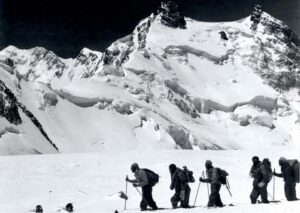These days it’s not unusual for all sorts of folks to scale England’s rugged Lake District mountains. But in the early 1800s, it wasn’t all that common, particularly for women. That didn’t stop Dorothy Wordsworth — best known as poet William Wordsworth’s sister — from tackling Scafell Pike in 1818.
The imposing Lake District peak rises 978m above sea level, making it England’s tallest mountain. Dorothy was an obsessive diarist and letter writer, and her account of the journey is detailed and well-written.
“I ought to have described the last part of our ascent to Scaw Fell Pike,” she wrote. “There, not a blade of grass was to be seen — hardly a cushion of moss, and that was parched and brown; and only growing rarely between the huge blocks and stones which cover the summit and lie in heaps all round to a great distance, like skeletons or bones of the Earth not wanted at the creation, and here left to be covered with never-dying lichens, which the clouds and dews nourish; and adorn with colours of the most vivid and exquisite beauty, and endless in variety.”

Dorothy Wordsworth as she looked in early middle age, at about the time she climbed Scafell Pike. Photo: Creative Commons
According to an article in the Independent, Dorothy’s words are the earliest written account of a woman climbing recreationally. Versions of the account ended up uncredited in her brother’s “Guide through the District of the Lakes,” leading many to believe it was William Wordsworth who made the ascent.
Unfair, but there’s a chance that Dorothy happily donated her recollections to her more famous brother’s walking guide. She somewhat notoriously devoted her entire life to assisting him with his literary pursuits.
An intense relationship
William and Dorothy were inseparable in ways scholars have long found disturbing or, at the least, problematic. “They were wrapped up in each other’s minds in…complicated and frightening ways,” biographer Frances Wilson told NPR upon the publication of her book about the female Wordsworth.
The siblings lived together in a Lake District residence called Dove Cottage, even after William’s marriage in 1802. This emotional and physical closeness seems to have worked out for both of them, however. William’s marriage lasted five decades, and Dorothy is thought to have provided both inspiration and critique for William’s prolific works.

Scafell Pike rises above the Lake District. Photo: Shutterstock
Along with poet Samual Taylor Coleridge, the siblings spent hours upon hours rambling around the Lake District. There, the group let the dramatic landscape inspire the literary and artistic movement that would come to life as Romanticism.
The Independent stated that Dorothy regularly walked more than 26km at a 6 kph pace. That’s an impressive clip for modern Lake District ramblers, let alone someone in 1818 sporting who-knows-what kind of footwear and restrictive women’s garments.
Raise a thermos
The Romantics believed in following internal ideals over external rules, a philosophy that no doubt contributed to Dorothy’s unusual (for the time) mountaineering feat. Today Scafell Pike is one of the prizes in the Three Peak Challenge — a popular challenge that has walkers scaling the highest peak in Wales, England, and Scotland, usually within 24 hours.
So the next time you’re tackling one of the Three Peaks, or a Marilyn, or, really, any mountain at all, raise a thermos to Dorothy Wordsworth. She didn’t let the cultural pressures of her time dictate her life outdoors, and we could all learn a thing or two from that.





